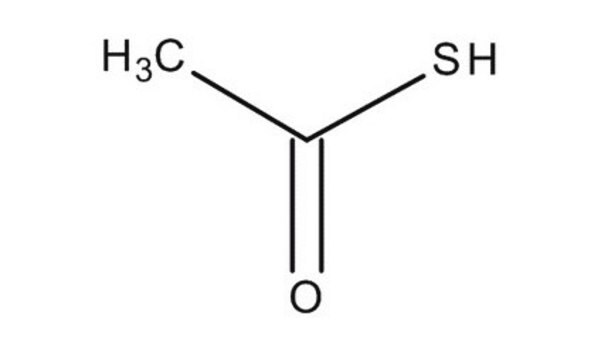251364
Acido formico
ACS reagent, ≥96.0%
About This Item
Prodotti consigliati
Grado
ACS reagent
Densità del vapore
1.6 (vs air)
Tensione di vapore
44.8 mmHg ( 20 °C)
Descrizione
dilution test passes test
Saggio
≥96.0%
Temp. autoaccensione
1004 °F
Limite di esplosione
57 %
Impurezze
≤0.4% Acetic acid
Residuo dopo evaporazione
≤0.003%
Colore
APHA: ≤15
Indice di rifrazione
n20/D 1.370 (lit.)
P. ebollizione
100-101 °C (lit.)
Punto di fusione
8.2-8.4 °C (lit.)
Densità
1.22 g/mL at 25 °C (lit.)
Anioni in tracce
chloride (Cl-): ≤0.001%
sulfate (SO42-): ≤0.003%
sulfite (SO32-): passes test
Cationi in tracce
Fe: ≤0.001%
NH4+: ≤0.005%
heavy metals (as Pb): ≤0.001%
Stringa SMILE
OC=O
InChI
1S/CH2O2/c2-1-3/h1H,(H,2,3)
BDAGIHXWWSANSR-UHFFFAOYSA-N
Cerchi prodotti simili? Visita Guida al confronto tra prodotti
Applicazioni
Avvertenze
Danger
Indicazioni di pericolo
Classi di pericolo
Acute Tox. 3 Inhalation - Acute Tox. 4 Oral - Eye Dam. 1 - Flam. Liq. 3 - Skin Corr. 1A
Rischi supp
Codice della classe di stoccaggio
3 - Flammable liquids
Classe di pericolosità dell'acqua (WGK)
WGK 1
Punto d’infiammabilità (°F)
121.1 °F - closed cup
Punto d’infiammabilità (°C)
49.5 °C - closed cup
Scegli una delle versioni più recenti:
Possiedi già questo prodotto?
I documenti relativi ai prodotti acquistati recentemente sono disponibili nell’Archivio dei documenti.
Il team dei nostri ricercatori vanta grande esperienza in tutte le aree della ricerca quali Life Science, scienza dei materiali, sintesi chimica, cromatografia, discipline analitiche, ecc..
Contatta l'Assistenza Tecnica.










